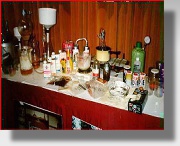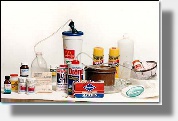CLANDESTINE DRUG ASSESSMENT
CERL, Inc
ENVIRONMENTAL CONSULTANTS
ENVIRONMENTAL CONSULTANTS
METHAMPHETAMINE
Methamphetamine is a synthetic amphetamine or stimulant that is produced and sold illegally in pill form, capsules,
powder, or chunks. Methamphetamine (Meth) is extremely addictive and can be smoked, inhaled, injected, or ingested.
Meth effects the central nervous system and causes the brain to release dopamine, a natural chemical that makes an
individual feel pleasure and eventually results in a permanent altering of the brain's natural chemistry.
Health Effects
Long-term methamphetamine abuse can cause addiction, anxiety, insomnia, mood disturbances, and violent behavior.
Additionally, psychotic symptoms such as paranoia, hallucinations, and delusions (such as the sensation of bugs
crawling under the user's skin) can occur. The psychotic symptoms can last for months or years after methamphetamine
use has ceased.
Methamphetamine is a highly addictive central nervous system stimulant that can be injected, snorted, smoked, or
ingested orally. Methamphetamine users feel a short yet intense "rush" when the drug is initially administered. The
immediate effects of methamphetamine include increased activity and decreased appetite.
Illicit Drug Lab Clean-up Hazards
Methamphetamine is easily produced in clandestine laboratories or meth labs using a variety of ingredients available in
stores. The manufacturing of methamphetamine is called "cooking". Cooking a batch of meth can be very dangerous due
to the fact that the chemicals used are volatile and the by-products are very toxic. Meth labs present a danger to the meth
cook, the community surrounding the lab, and the law enforcement personnel who discover the lab
The primary hazard associated with improper clean-up of a lab is the presence of residual amounts of the drug.
Secondary hazards include physical injury hazards, biological hazards and the various types of chemicals used in the
manufacture of the drug which can pose health risks to all persons working or occupying the facility.
Meth lab sites often contain hazards other than just those associated with the production of methamphetamine. These
include bloodborne pathogens from bodily fluids, contaminants associated with poor house keeping, poor hygiene, the
presence of sharp objects, unmarked/labeled containers, electrical hazards, slips/trips/fall hazards and possible ‘booby
traps'.
Regulations
The CIty of Albuquerque and the New Mexico Environment Department have adopted strict regulations that require the
property owner to conduct thorough clean–up, including pre- and post-clean up testing, for properties (including vehicles)
that have been used for the manufacture of methamphetamine.
These properties will be posted by law enforcement and must be certified as meeting strict clean-up standards before
they can be reused, sold, rented or even just entered.
New Mexico is currently experiencing a growth in the illegal manufacturing of methamphetamine. The homes, structures
and even vehicles used for manufacture pose a health risk even after the lab is gone - especially to young children.
Illicit Drug Lab Clean-up Hazards
Methamphetamine is easily produced in clandestine laboratories or meth labs using a variety of ingredients available in
stores. The manufacturing of methamphetamine is called "cooking". Cooking a batch of meth can be very dangerous due
to the fact that the chemicals used are volatile and the by-products are very toxic. Meth labs present a danger to the meth
cook, the community surrounding the lab, and the law enforcement personnel who discover the lab.
The primary hazard associated with improper clean-up of a lab is the presence of residual amounts of the drug.
Secondary hazards include physical injury hazards, biological hazards and the various types of chemicals used in the
manufacture of the drug, including lead, mercury, pool acid/muriatic acid (hydrochloric acid), lye, acetone, brake fluid,
brake cleaner, Iodine crystals, Lithium metal from crushed batteries, lighter fluid, drain cleaners, pseudoephedrine
(Sudafed®), ethyl ether (starting fluid), anhydrous ammonia, sodium metal, red phosphorus, ephedrine, etc., all of which
can pose health risks to persons working or occupying the home or building for years to come.
The mandated clean-up of drug lab properties can cost $10s of thousands of dollars. This makes the pre-testing,
remediation specifications and final clearance testing critical to avoid unnecessary expense in the clean-up.
To avoid serious legal and liability consequences, be sure an select companies with the kind of education, training and
experience to get the job done right!
CERL services include pre- and post remediation testing to determine the levels of contaminants in the building/home
using sampling protocols that will stand the 'test of evidence' needed to satisfy both the City of Albuquerque and New
Mexico Environmental Department requirements for clearance testing and possible future legal actions.
The face of meth use!






